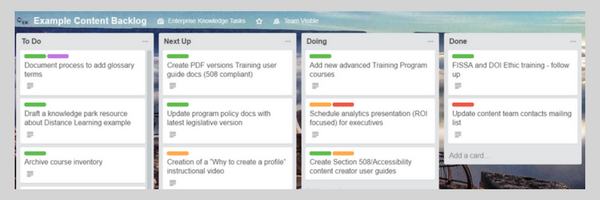Part 2:
...
How would you like to be a Guest Blogger for KMI? Email us at: info@kminstitute.org and let us know your topic(s)!
While “going agile” is not an end in itself, there are circumstances where an agile content strategy can help achieve desired business outcomes. In part 1 of this two-part blog series, we discuss content team implementation of agile ceremonies which have brought success to EK clients. In part 2, we’ll follow up with a discussion of traditional Scrum roles and how they can be applied to content teams.
Agile Content Team Ceremonies
More than just meetings, agile ceremonies are designed to empower teams by maximizing the investment of each team member’s time. Here are some examples in which EK has successfully employed agile ceremonies to empower content teams.
Content Sprint Planning
Anyone who’s ever worked on a content team knows that creating a prioritized content backlog is arguably the greatest value which agile can add to content strategy. Content tasks often come to content teams in a flurry of urgent requests and unrealistic timelines. Adding incoming requests to a product backlog and making that product backlog visible to stakeholders can go a long way towards setting realistic expectations for content production timelines.
Once the content backlog is established, sprint planning meetings provide an opportunity for content teams to engage in dialog with the product owner and discover the business objective, audience, and topic of content tasks.

In this example the product backlog consists of all tasks in the “To Do” column.
As with any sprint planning meeting, estimating the amount of effort it will take to accomplish each content task is essential. We’ve found simple metrics to estimate effort such as T-shirt sizes (small, medium, large, extra large) are helpful for non-technical teams like content teams. Reformatting that PDF to ensure it’s 508 compliant? That’s a small task. Producing that new user help video? That’s a large task.
Once T-shirt sizes are agreed to for each upcoming task you can chart the content team’s velocity. As with any agile team, ensure the team commits to a realistic amount of work for the sprint – based on their known velocity. But let’s be honest – it’s highly likely that a content team will be asked to take on more than they can realistically handle. It’s also highly likely that “urgent” tasks will be requested mid-sprint. Business stakeholders requesting urgent content tasks will have to be educated about new agile processes – and their business value.
Content Daily Stand-Up
Once a content team has committed to completing the tasks in the current sprint (the main outcome of the sprint planning meeting), daily stand-up meetings are essential to achieving this collaboratively set goal. The typical format is 15 minutes in which the entire team answers three questions:
Daily stand-ups are an opportunity for the entire team to explicitly commit to meeting the goals of the current sprint at the beginning of each day. This may mean dynamically adjusting tasks which are assigned to team members. If one team member has completed a first draft of a new publication, perhaps another team member can jump in and offer to review it and give feedback. If one team members is a stronger writer and is struggling with a visual design, they can ask for assistance. The focus of the daily stand-up is on the team working together to complete all of the tasks in the sprint, shifting tasks and offering expertise as needed to best make that happen.
Content Sprint Review
The focus of a development sprint review is to ensure that the goal of the sprint is met – often a final check against acceptance criteria. Usually, the team presents to the product owner. Content publication is usually not as technical and the business requirements are relatively easy to understand. An entire ceremony to validate that acceptance criteria are met is not as valuable for content teams.
For content teams, it is really easy for the completion of daily tasks to go unrecognized. Does anyone stop to take notice when a routine article is published? It’s not only large publication milestones that deserve recognition.
Sprint reviews in the form of “Demo Fridays” can be a good strategy to ensure that the work of your content producers is valued. Each member of the team has the opportunity to show off all new content which was published during the week. The ScrumMaster sets the tone here, and it should be celebratory, honoring tasks completed, noting attention to detail and quality, and acknowledging roadblocks overcome.
Content Sprint Retrospective
Sprint retrospectives cultivate the culture of continuous improvement which is so essential to content teams. Content production is a bit of an art, with an emphasis on soft skills like writing with style and clarity. These skills require continuous honing – there’s always more to learn.
The goal of a sprint retrospective is not to improve content production skills, but rather to improve the agile processes which enhance content production. However, the inclusion of sprint retrospectives in the processes of your content team models the continuous improvement which is so critical to the overall culture.
Recently a content team which worked with EK discovered and implemented a process improvement due to a retrospective. The content team was using Trello to manage content tasks and a subset of business stakeholders were uncomfortable with the platform. This was causing poor communication during the editorial process. These particular business stakeholders were creating a spreadsheet where each row was a task. Rather than force the business stakeholders to use Trello, the team revised their process to link from Trello to their stakeholders’ spreadsheet. The hybrid approach enabled more regular communication with the stakeholders, but still honored the content team’s processes.
Conclusion
Agile ceremonies are just one component of agile processes, but they are a highly visual and recognizable one. When people talk about “going agile,” they often default to agile software development, but agile ceremonies (and other agile practices) can empower many kinds of teams – including teams of content producers. Do you need help empowering your content teams with agile practices? Contact us at Enterprise Knowledge – we can help.
 About the Author: Rebecca Wyatt is a skilled trainer, content strategist, and project manager who is focused on empowering teams and maximizing learning. Rebecca is a self-described "learning addict" who is at her best collaborating with and inspiring teams to greater success. More from Rebecca Wyatt »
About the Author: Rebecca Wyatt is a skilled trainer, content strategist, and project manager who is focused on empowering teams and maximizing learning. Rebecca is a self-described "learning addict" who is at her best collaborating with and inspiring teams to greater success. More from Rebecca Wyatt »
...